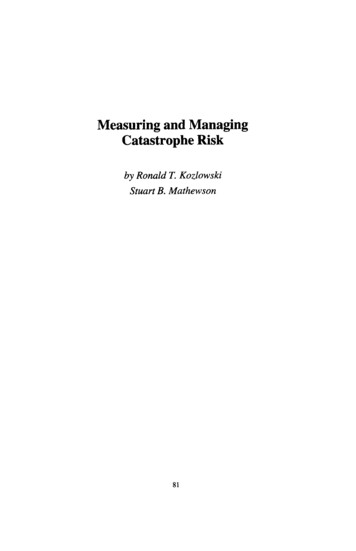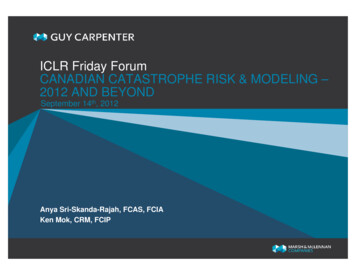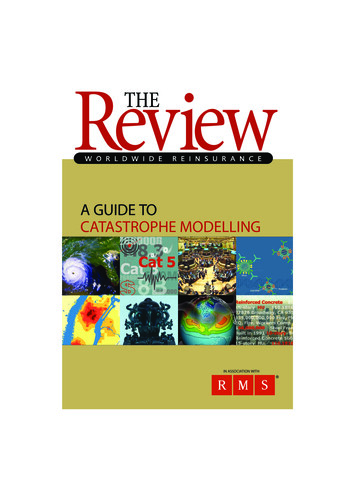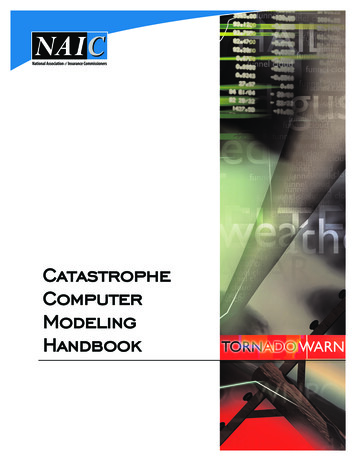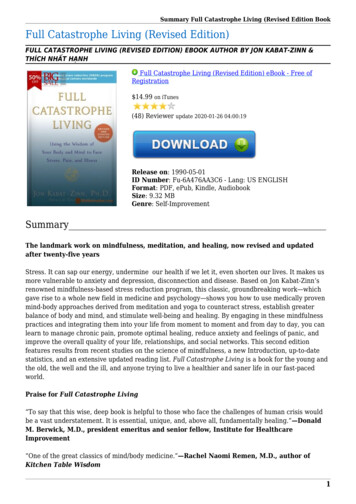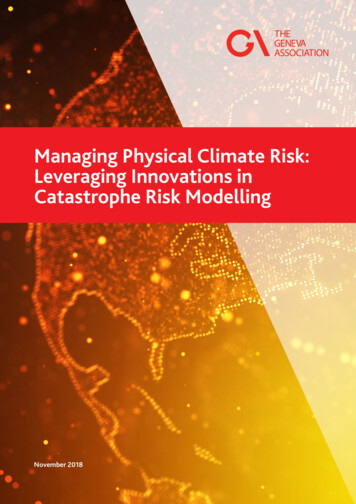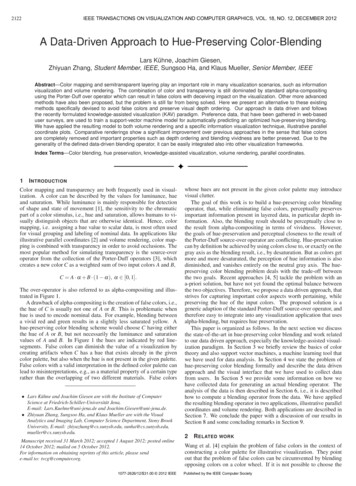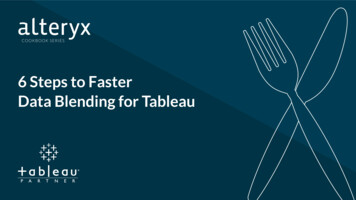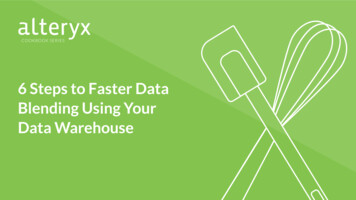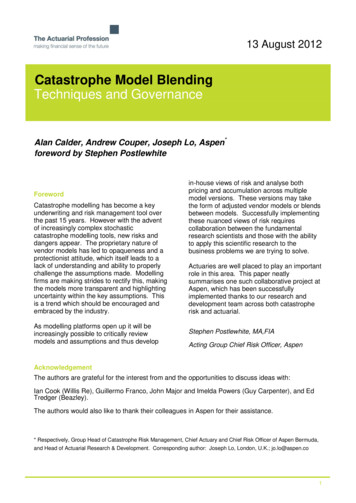
Transcription
13 August 2012Catastrophe Model BlendingTechniques and GovernanceAlan Calder, Andrew Couper, Joseph Lo, Aspen*foreword by Stephen PostlewhiteForewordCatastrophe modelling has become a keyunderwriting and risk management tool overthe past 15 years. However with the adventof increasingly complex stochasticcatastrophe modelling tools, new risks anddangers appear. The proprietary nature ofvendor models has led to opaqueness and aprotectionist attitude, which itself leads to alack of understanding and ability to properlychallenge the assumptions made. Modellingfirms are making strides to rectify this, makingthe models more transparent and highlightinguncertainty within the key assumptions. Thisis a trend which should be encouraged andembraced by the industry.As modelling platforms open up it will beincreasingly possible to critically reviewmodels and assumptions and thus developin-house views of risk and analyse bothpricing and accumulation across multiplemodel versions. These versions may takethe form of adjusted vendor models or blendsbetween models. Successfully implementingthese nuanced views of risk requirescollaboration between the fundamentalresearch scientists and those with the abilityto apply this scientific research to thebusiness problems we are trying to solve.Actuaries are well placed to play an importantrole in this area. This paper neatlysummarises one such collaborative project atAspen, which has been successfullyimplemented thanks to our research anddevelopment team across both catastropherisk and actuarial.Stephen Postlewhite, MA,FIAActing Group Chief Risk Officer, AspenAcknowledgementThe authors are grateful for the interest from and the opportunities to discuss ideas with:Ian Cook (Willis Re), Guillermo Franco, John Major and Imelda Powers (Guy Carpenter), and EdTredger (Beazley).The authors would also like to thank their colleagues in Aspen for their assistance.* Respectively, Group Head of Catastrophe Risk Management, Chief Actuary and Chief Risk Officer of Aspen Bermuda,and Head of Actuarial Research & Development. Corresponding author: Joseph Lo, London, U.K.; jo.lo@aspen.co1
Catastrophe Model Blending1Introduction1.1The Purpose of the PaperIn this introductory section, we shall see the following pattern of activities when using multiple models inpricing: Obtain results from multiple models Critically compare and contrast these results against one another, as well as against one’s own morequalitative assessments, so that strengths and limitations of each of the models would be highlighted Given this critical assessment, weights are placed on them for weighted averages to be taken (somemodels can and will have zero weights)This is a common practice in our day-to-day actuarial work. A key contribution this paper will make is thatthese three steps can also be taken when accumulating catastrophe exposures. In Sections 4 and 5.1, giventhat there is typically more than one model available, we will argue that to understand catastropheaccumulations well, the first two steps are very important to perform. We expect these two steps to becommon practice already for firms that have material exposures to catastrophe risk. However, for a variety oftechnical and operational reasons, the third step is not typically taken up, even in cases when blending wouldbe very commonly performed in other areas of work such as pricing. The paper will suggest that: Openness to blending is important when using multiple models – even if one will not blend in everysingle catastrophe peril and zone. With this openness, the undertaking of the first two steps wouldhave greater value. There are technical methods available for blending catastrophe accumulations. This will be discussedin general in Section 2 and a specific example technical solution is presented in Section 3. Throughthe use of a general discussion and a discussion surrounding a detailed example, technical andconceptual considerations will be reviewed in depth, allowing us to share with the reader some of thechallenges we have faced in our experience of blending.oAmong the many technical concepts considered in this paper, we shall consider the merits oftwo commonly employed ways of blending outputs of catastrophe models, indicating ourpreference for one over the other (see Section 2.1). oWe shall also stress that there is a variety of ways to conduct “a straightforward 50-50blend”, urging practitioners to qualify such phrases with methodological comments(see Section 2.2.1)We shall explore how blending can be related with uncertainty. In particular, we shall highlightthat: We cannot reduce all uncertainty by blending multiple models. In particular, commondatasets and common scientific theories are two dominant reasons why we cannot doso. We can reduce our vulnerability to drivers of uncertainty that are specific to theindividual models, through using particular types of blending (see Section 2.1.2, and inparticular 2.1.2.3). We also begin to consider blending as a tool to reduce the negative consequences ofuncertainty (see Section 2.1.1.2, and also 2.1.2.4), posing questions for futureresearch.2
Catastrophe Model Blendingo The example technical solution will also indicate how one may enter different adjustments fordifferent portfolios in an accumulation. This is extremely important where one would like toblend with, for example, outputs of experience rating models.Governance is a key operational part of the use of multiple catastrophe models. We shall explore thisin Section 4. Referring the reader to existing literature on general governance concepts, we shallhighlight model validation and governance activities that we have found particularly helpful. In relationto blending, we consider how specific ways of blending – for example, as in Section 3 – can also helpthe governance of the use of catastrophe models in general, by providing a faster quantitativefeedback loop to channel expert opinions.As the reader is (or will be) aware, existing good and thoughtful literature already exists on the areas of theuse of multiple models and model governance. As much as possible, we shall make references to it and avoidrepetition. We note that an overwhelming proportion of this literature is authored by brokers, catastrophemodelling specialists, and industry and regulatory bodies. It is, therefore our hope throughout its production,that this paper would make a unique contribution to these topics from the perspective of a (re)insurer, giving usan opportunity to begin a debate among (re)insurer practitioners on the various challenges and solutionsfacing us.For ease of navigation and reference, we include a table of contents here. In summary: The remainder of this introductory section sets up the background and motivation for the discussion inthe further sections. We shall explore existing blending methodology in Section 2, discussing the merits of differentapproaches, indicating a preferred approach. A detailed example blending solution is described in Section 3, using our preferred blending approachfrom the previous section. It will also explore a wide variety of issues in blending such as adjustmentsfor individual portfolios. A discussion on governance of uses of catastrophe models can be found in Section 4: especially inrelation to the blending demonstrated in the previous two sections. Further topics are discussed in Section 5, touching on Solvency II, non-modelled perils and the futureof catastrophe model blending.This paper assumes a basic understanding of the concepts of catastrophe models and their outputs, relying onthe readers’ familiarity with commonly used terminology. We expect the printed version of this paper will be inblack and white. A full colour version can be downloaded from the Actuarial Profession website.3
Catastrophe Model BlendingContents123456Introduction . 21.1The Purpose of the Paper . 21.2Catastrophe Modelling . 51.3Types of Uncertainty. 61.4The Pricing Process. 71.5The Accumulation Process . 81.6Pricing and Accumulation Example: UK and France Windstorms .91.7Use of a Single Unadjusted Model .111.8Use of Multiple Models .111.9Comments on the Use of Multiple Models .121.10Quantitative Feedback Loops .13Catastrophe Model Blending .152.1Two Natural Ways of Blending .152.1.1Severity blending .152.1.2Frequency blending .172.1.3Comparisons between frequency and severity blending .182.2Arithmetic and Geometric Averages .222.2.1What is a “50-50 blend”? .222.2.2Implementation difficulties .232.3Literature on Model Blending .24A Technical Solution .253.1Tables and Notations .253.1.1The Year Event Table .253.1.2Event Loss Tables .263.1.3Year Loss Tables .283.2Standard Agreed Blend .293.2.1Selection of weights .293.2.2Deciding on the number of simulations, N .303.2.3Defining the Year Event Table .313.2.4Obtaining the portfolio ELTs and YLTs .373.2.5Producing the Year Loss Tables .383.2.6Secondary uncertainty dependencies .403.2.7Other variations and further research .403.3Bottom-up adjustments .433.3.1Uniform scaling .433.3.2Variable adjustments .443.3.3Uncertainty of adjustments .473.3.4Dependency considerations .47Governance .524.1Governance of the standard agreed blend .524.1.1Vendor model validation .524.1.2Governance committees and model adoption .554.2Governance of the bottom-up adjusted blend .554.2.1Account level governance .564.2.2Portfolio level governance .57Final Words .585.1Solvency II .585.1.1The use of multiple models in the Internal Models .585.1.2Documentation and validation implications for the bottom-up adjustments .585.2Non-Modelled Perils.595.3Future Direction for Blending Approaches .60Works Cited .614
Catastrophe Model Blending1.2Catastrophe ModellingCatastrophe Modelling has been in use within the (re)insurance industry since the late nineteen eighties. Theearliest models were largely deterministic models, allowing users to estimate “as-if” losses for either historicalevents, or “what if” type “worst case” set of scenarios. However, beginning in the early nineties, models beganto be produced on a fully probabilistic basis, simulating tens to hundreds of thousands of possible catastropheevents in order to estimate a more complete range of potential losses for a given peril.Catastrophe models are now adopted by the (re)insurance industry, in an attempt to provide improvedestimates of exposures to extreme events. Entities may have only limited actual loss experience with which toquantify such exposures. This was the situation in Florida in 1992 when Hurricane Andrew hit to the South ofMiami as a strong category four hurricane. A number of insurers failed principally as they relied on trendingloss experience from the previous two decades: decades with few hurricane landfalls in the state and duringwhich insured values increased, construction codes changed and the coverage detail also changed.Well researched catastrophe models have the benefit of using longer records of observed hazard informationof up to a hundred years to attempt to quantify the recurrence of extreme events, although often vulnerabilitycomponents within models are inferred from much more limited observations.Models are typically used as part of two main underwriting processes: in order to calculate expected losses, standard deviations of losses, and probabilities of losses to(re)insurance contracts for individual risks or portfolios for pricing; or to estimate the overall level of accumulation of several risks or contracts to a given peril or all perils,usually reported as an annual loss percentile such as 1% or “1 in 100”, or fed directly into stochasticcapital models.We shall discuss each of these processes in Sections 1.4 and 1.5 in more detail. For more details oncatastrophe models themselves: The UK Actuarial Profession organises regular catastrophe modelling seminars – a recent one washeld in March 2011, with speakers from major catastrophe modelling companies, as well as fromactuarial practitioners. In particular, the present paper will regularly refer to the slides from the talk(Cook, 2011). At least two recent GIRO Working Parties considered natural catastrophes and reported back: one in2002 (Sanders & others, 2002) and then in 2006 (Fulcher & others, 2006). The 2002 report deals withextreme events in general, with its Section 4 devoted to catastrophe modelling. The 2006 reportdiscusses catastrophe modelling, with a focus on North Atlantic hurricanes. In the US, the Casualty Actuarial Society organises annual Ratemaking and Product ManagementSeminars. The March 2009 and March 2010 seminars both had catastrophe modelling workshops,the slides of which can be downloaded. (Grossi & Kunreuther, 2005) is a collection of essays that introduces catastrophe modelling, includingconsideration of how natural hazards are assessed and the topic of uncertainty. Insuranceapplications also feature in this book. (Woo, Calcualting Catastrophe, 2011) is a thoughtful – and thought-provoking – account of thesubject. It considers catastrophes more generally, citing recent financial catastrophes as examples. Itcan be considered as a second edition to (Woo, The Mathematics of Natural Catastrophes, 1999).5
Catastrophe Model Blending1.3Types of UncertaintyA key concept with catastrophe modelling is that of epistemic and aleatory uncertainties. These are twoscientific terms used to categorise different sources of uncertainty – we quote from Section 4.2 of (Grossi &Kunreuther, 2005): Epistemic uncertainty is the “uncertainty due to lack of information or knowledge of the hazard” Aleatory uncertainty is the “inherent randomness associated with natural hazard events, such asearthquake, windstorms and floods”To this, it is helpful to add an additional uncertainty category: implementation uncertainty. There is adifference between: a scientific / mathematical or statistical model, and an implementation of such a model.Even a perfect scientific model is implemented by human beings, who are fallible: mistakes can be made evenwith very good governance and peer review regimes! With the constraint in computing power, simplificationsof the scientific models – for example, through discretisations of continuous models or simulations of statisticalmodels – lead to approximations of the models, not the precise models themselves. Implementation ofmodels, then, introduces another layer of uncertainty.The key characteristic of epistemic uncertainty is that it can be reduced through, for example, collection ofmore data, and development of scientific knowledge. Implementation uncertainty can also be reducedthrough, for example, better implementation techniques and computing power. However, aleatory uncertaintycan never be reduced by our modelling or model implementation efforts. In light of this, when we consideruncertainty in relation to catastrophe models in this paper, where unqualified, we refer to epistemic andimplementation uncertainty.Epistemic uncertainty is especially dominant in catastrophe modelling, as it relies on models to deal with largeextrapolations into extreme events – many of which we have never observed in history. Simple statisticalbootstrap procedures can show wide uncertainty bounds at the higher return periods (such as 1 in 100 year).Surely to the benefit of the industry, and the consumers and investors the industry serves, Solvency II isalready giving a big push into understanding such uncertainty: we expect this effort to continue.We shall consider in this paper how the use of independently developed catastrophe models can be used toengage with epistemic and implementation uncertainty. In particular, in Section 2.1.2.3, we shall define a newtype of uncertainty, which is a subset of epistemic and implementation uncertainty: our reliance on uncertaintyfrom idiosyncratic features of particular model (implementations) can be reduced by the some methods ofblending.Before we move on, it would be useful to be clear on how the terms “model” and “model uncertainty” will beused in this paper.The term “model uncertainty” is more familiar to actuaries. Model uncertainty is the uncertainty associatedwith the specification of the model: e.g. whether hurricane landfalls should be modelled by Poisson orNegative Binomial. This narrow type of model uncertainty is difficult to judge, and is usually assessed throughsensitivity testing.“Model uncertainty” can also mean the uncertainty associated with using implementations of models as withvendor “models”. This is a handy interpretation when we have a few model outputs of the same risk tocompare and contrast. It is at the same time narrower than the strict definition of model uncertainty and wider.It is narrower in the sense that by gauging only a handful of models, there is little chance that we would obtainthe full space of model uncertainty. For example, there may be more than three competing scientific theoriesin modelling a particular physical process; or there is every chance that our current scientific or engineeringknowledge in the future will include significant concepts and understanding of reality that we do not know ofnow. It is wider, in the sense that epistemic uncertainty would include a whole range of other “uncertainties”,such as “black swans”, parameter uncertainty, data uncertainty, uncertainty surrounding the interpretation ofdata, or modelling resolution uncertainty. These example uncertainties are linked with one another. If morerelevant data is available, parameter uncertainty would reduce, while simultaneously, we would have a betterchance of testing and refining model specifications, and hence reduce model uncertainty (in the stricter sense).6
Catastrophe Model BlendingTo avoid confusion, we shall refrain from using the term “model uncertainty” in this paper. However, in linewith common practice, we shall abbreviate implementations of scientific models to “models”: and it is in thissense that we shall describe, for example, “vendor models” as models.1.4The Pricing Process“Pricing” is a critical part of the overall underwriting process and must allow for all applicable terms andconditions that may impact the potential cash flows arising from a contract.The process defined as “pricing” can include providing premium quotations to brokers and/or current andprospective policyholders and also deciding upon the share of a risk to accept at the offered premium. Often adistinction is made between the premium that a policyholder is charged, the internal technical premium and awalk-away or minimum premium.The technical premium is an internal view of how much should be charged to cover all anticipated cash flowsas well as provide the expected profit margin the company requires. Commercial considerations will drive thedifference between the actual premium charged and the technical premium.For a given class of business, the technical price will generally be calculated systematically and include: A contribution towards the expected cost of all claims that could be suffered by the company. Thiswould include allowance for large and catastrophe claims that may not necessarily be seen within theobserved claims experience. The relevant loads for large and catastrophe losses may be determinedby exposure analysis, portfolio analysis and/or underwriting judgment. Loadings to cover internal expenses and external costs, including outwards reinsurance; and A profit margin consistent with the company’s long term target rate of return.The expected loss cost for catastrophe perils will generally be determined using exposure analysis. In manycases catastrophe models will be used as the basis. However this should be supplemented where applicableby experience rating. The limitations of both experience rating and exposure rating have to be borne in mindby the pricing actuaries and underwriters.The use of catastrophe models is fraught with difficulties. The validity and accuracy of the exposure data usedas the input to the model is critical in determining the reasonableness of the output. The exposure datashould be analysed carefully before use, ensuring the geocoding is as accurate as possible. Any changesexpected in the portfolio between the data presented (which will usually be at a given point in time andprovided by a broker) and an appropriate point during the period to be insured (usually the mid-point), shouldbe incorporated.Below are some further questions in the process: Have all perils been allowed for in the modelling? If not, how will they be incorporated? What view of catastrophe model output should be used for pricing?oooWith or without secondary uncertainty?With or without demand surge?With or without fire-following? What allowance could or should be made for uncertainty? The company may have an in-house research and development team. This team may also have aview of certain models, or parts of certain models. Will this be incorporated into the pricing process?7
Catastrophe Model BlendingThis paper will discuss blending tools to engage with the last two questions, although we shall touch on nonmodelled perils in Section 5.2.There is a wide variety of methods to calculate the profit margin. Capital requirements and allocations aretypically key inputs into the calculations. A key common theme is that the size of the profit margin should insome way be linked with the risk associated with the contract to the company. Catastrophe model outputs areinstrumental to assessing the catastrophe components of this risk.When pricing, underwriters review output from the vendor models. For modelled perils, they may blendmodels together or they may make adjustments to a single model to take into account specific characteristicsof the account being priced. Non-modelled perils will be allowed for separately. Once the account has beenbound, the account will be added to the portfolio and the focus will then turn to accumulation, which we shalldiscuss in the next section.Some companies also use a walk-away or minimum premium. This will follow the same process as thetechnical premium but with modified assumptions for some items. For example the expense assumptions maybe modified so that only direct expenses are considered and no additional contribution to indirect expenses isrequired.The references in Section 1.1 above should give the reader more detailed information on pricing catastropherisks in insurance and reinsurance (for example, Section 4.3 of (Sanders & others, 2002) and Section 2.3 of(Fulcher & others, 2006)). A range of good papers are available on pricing in general: the UK profession’sworking party 2007 report on pricing (Anderson & others, 2007) is a good reference, and itself contains abibliography in specific areas of pricing.1.5The Accumulation ProcessFor catastrophe perils, the accumulation process considers the aggregation of modelled losses from a givenperil. The aggregation can be at many different levels including across classes of business, segments andalso the entire portfolio of the company.Catastrophe models are generally event-based systems. In a model with a consistent event set, the allowancefor correlation between different contracts within a portfolio is then very straight forward. The expected lossesacross the portfolio can be summed for each event. Other statistics can then be evaluated for each eventsuch as the standard deviation and also the maximum loss for the event given the underlying exposure(provided there are no unlimited policies within the portfolio).The accumulation process will then consider the overall losses that could be expected for different segmentsof the portfolio in a given year. The catastrophe models tend to focus on two different views for modelledperils:1. The maximum loss that occurs in a given year. The distribution curve for the maximum loss is knownas the occurrence exceedance probability (“OEP”) curve; and2. The aggregate loss in a given year. The distribution curve for the aggregate loss is known as theaggregate exceedance probability (“AEP”) curve.The metrics can be evaluated across the entire portfolio, or broken down by segments such as a class ofbusiness. It could also be constructed for all perils or just based on a single peril. Some companies like tofocus on a specific region for a given peril such as Florida Wind within all US Wind, or California earthquakewithin all US earthquake.For each peril the company will generally have a standard view of how it should be modelled. This will eitherbe a single vendor model or a ble
Catastrophe modelling has become a key underwriting and risk management tool over the past 15 years. these nuanced views of risk requireHowever with the advent of increasingly complex stochastic catastrophe modelling tools, new risks and dangers appear. The proprietary nature of vendor models has led to opaqueness and a
